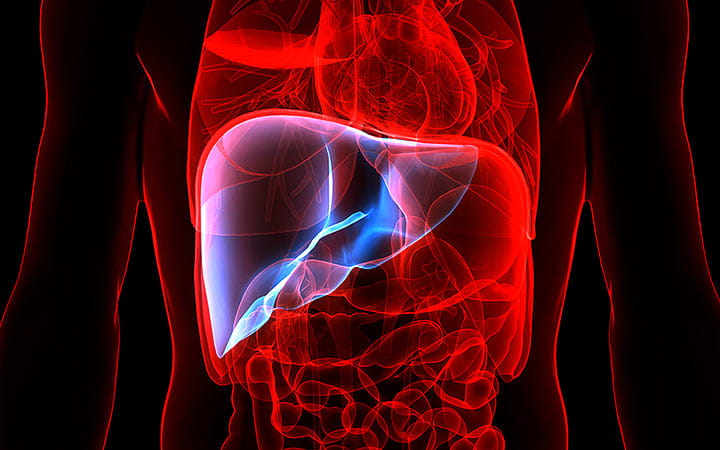Non-Alcoholic Fatty Liver Disease: Common Condition You Can Do Something About
September 24, 2021

One in four adults in the United States has non-alcoholic fatty liver disease, in which excess fat accumulates in the liver. The good news is that you can take steps to get rid of this disease, which, in some cases, can lead to cirrhosis.
What is Non-Alcoholic Fatty Liver Disease?
Non-alcoholic fatty liver disease is the accumulation of fat in the liver cells as shown by imaging or histologic study. The disease is not caused by alcohol, medications, infections or hereditary or autoimmune liver diseases.
Non-alcoholic fatty liver disease has two subtypes: non-alcoholic fatty liver disease and non-alcoholic steatohepatitis (NASH).
Non-alcoholic fatty liver disease is the mildest form of the disease. People with non-alcoholic fatty liver disease have extra fat in the liver, but there is no or little inflammation in the liver.
Non-alcoholic fatty liver disease has a lower rate of disease progression than NASH and only about 4 percent of patients develop cirrhosis, which is a condition of scarring and inflammation in the liver with liver malfunction.
In contrast, non-alcoholic steatohepatitis (NASH) is a more severe form of the non-alcoholic fatty liver disease. People with NASH have inflammation and damage in the liver in addition to extra fat in the liver. More than 20 percent of patients with NASH develop cirrhosis in their lifetime.
In addition, these patients are at increased risk of developing liver cancer. About 5 percent of adults in the United States have NASH.
Causes of Non-Alcoholic Fatty Liver Disease
Although the exact cause of non-alcoholic fatty liver disease is still unclear, it is believed that insulin resistance or an impaired body response to insulin leads to an increased flow of free fatty acids into the liver. The free fatty acids are the building blocks of the fat in our bodies. Elevated insulin levels and insulin resistance also promote the production of triglycerides or fat in the liver.
The combination of these two processes contributes to the development of fatty liver.
Risk factors for non-alcoholic fatty liver disease are:
- Being of Hispanic or Asian descent
- Post-menopausal women
- Obesity, especially when the fat is concentrated in the abdomen
- High blood pressure
- Type 2 diabetes
- High cholesterol
- Polycystic ovary syndrome
- Sleep apnea
- Low thyroid
Signs and Symptoms
Patients with non-alcoholic fatty liver disease usually do not have any signs or symptoms. Occasionally, they may experience fatigue, weakness, or pain or discomfort in the abdomen. Many patients with NASH may not have any signs or symptoms either.
With disease progression, patients with NASH, especially when they develop liver cirrhosis, can have signs and symptoms such as:
- Distended belly
- Visible patches of spider veins on the chest, back, face, neck or arms
- Yellowing of the skin and eyes
- Red, blotchy areas on the hands
- Enlarged spleen
Other symptoms include extreme fatigue, weakness, weight loss, leg swelling, bleeding, muscle wasting and confusion.
Usually Discovered at the PCP's Office
Non-alcoholic fatty liver disease is usually discovered coincidentally at the primary care physician’s office. To diagnose the condition, your doctor may recommend:
- Blood tests
- Abdominal ultrasound
- Computed tomography scan or magnetic resonance imaging of the abdomen
- Transient elastography like FibroScan, that measures the stiffness of the liver and the amount of fat in the liver. Liver stiffness indicates fibrosis or scar tissue of the liver.
- Magnetic resonance elastography, which also measures stiffness
- Liver biopsy, which is the gold standard for the diagnosis of NASH
How You Can Combat Non-Alcoholic Fatty Liver Disease
Once diagnosed with non-alcoholic fatty liver disease, patients should focus on lifestyle changes such as a healthy diet, exercise and weight loss. These changes are the most effective treatment for the non-alcoholic fatty liver disease.
A low-calorie, low-fat diet helps reduce the amount of fat in the liver. For people who are overweight or obese, a 10 percent weight loss has been shown to reduce the amount of fat in the liver and reduce liver inflammation.
Consumption of fructose, a type of sugar, has been associated with NASH development and the progression of liver fibrosis or scarring in patients with non-alcoholic fatty liver disease. Avoid food and drinks that are high in fructose such as sugar-sweetened soda, honey, molasses, high-fructose corn syrup, dried fruits, fruit juices, apples, grapes, etc. Foods low in fructose include blueberries, strawberries, carrots, avocados, green beans and lettuce.
Exercise reduces insulin resistance, and decreases liver fat content independent of weight loss. The American Medical Association recommends more than 150 minutes of exercise per week.
Limit or abstain from alcohol. For men, alcohol should be limited to no more than four drinks on any day or 14 drinks per week. For women, alcohol should be limited to no more than three drinks on any day or seven drinks per week.
Avoid over-the-counter medications. People with non-alcoholic fatty liver disease should be vaccinated against hepatitis A and B if they are not immune. Although there is no FDA-approved medication for the treatment of non-alcoholic fatty liver disease, medications such as vitamin E and pioglitazone can be considered for biopsy-proven NASH.
Consult your physician whether these medications are appropriate for you. Bariatric surgery can be a treatment option for individuals who are obese and are unable to lose weight.
Yonghin Chen, MD, PhD, is a primary care physician at UH Mantua Health Center.
Related Links
At University Hospitals, we believe having a primary care provider is essential to your health and well-being. Our primary care physicians and nurse practitioners provide comprehensive, compassionate and continuous primary care for patients of all ages. We are committed to building a healthy relationship with you and your family to detect and minimize long-term health issues, or just help you get over that illness that's going around. Need a primary care provider? Find one here.
Tags: Primary Care


